Sunny Boy Smart Energy: A Practical Test
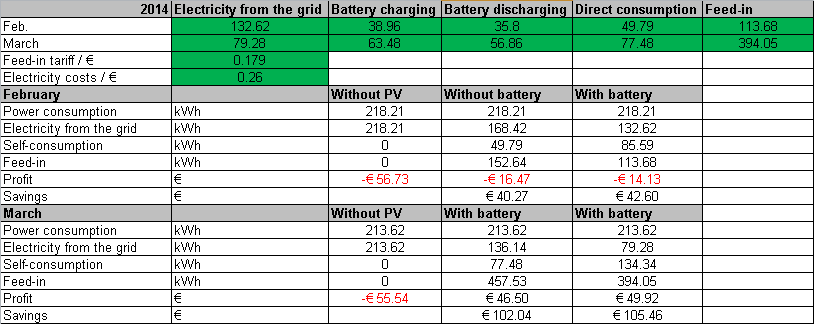
As an SMA employee, I was able to familiarize myself with the new Sunny Boy Smart Energy in the test phase. Many of you are probably wondering why you should invest in an inverter with a battery, so I would like to share my experience and take you through a few questions that could help you make a decision.
My current system is a Sunny Boy 3600SE-10 with a 2-kWh battery without Sunny Home Manager via WebConnect. My solar power output is 4.75 kWp. I receive 17.9 cents for each kWh I feed in. I have been running a battery inverter in my system for the last two months. Here are my experiences:
Installation
The Sunny Boy Smart Energy is really very simple to install: Attach the wall mounting bracket with bolts as shown in the assembly instructions, hang the inverter, hang battery on the wall mounting bracket, and then connect the cables from the battery and the inverter. The SMA Energy Meter is a must, of course, since it is necessary for the inverter to operate correctly. The Energy Meter provides the inverter with the current measurement data on electricity drawn from and fed into the grid.
Switch It on and Register on the Portal. Done!
The battery is ~ 25% charged by default.
Our three-person household consumes 2,800 kWh annually. Everyone should calculate out the value for their own household, however, because the numbers here only apply for my household. Our average consumption is 7.7 kWh per day. I’d like to first show how the inverter works on two typical days and what contribution the battery inverter makes.
A Sunny Day (March 10, 2014):
Both my wife and I work, so our power consumption during the daytime is very low. Once the sun was up over the horizon, my system started generating current for direct consumption. The inverter started charging the battery as soon as the energy generated was greater than our consumption. The inverter knew from experience, however, that the day was going to be sunny and that power consumption would be low during the day, so it stopped charging the battery and just fed into the utility grid. It fully charged the battery only around noon. In the afternoon, when the PV energy decreases, it switched the battery into discharge mode, as consumption began to exceed the PV energy.
We then were able to use energy from the battery until midnight. The yield was so high on this particular day that the PV system was able to cover 70% of our power consumption. Of the 5.5 kWh we consumed, we used 1.85 kWh directly from the PV system and 1.89 kWh via the battery.
Not every day this early in the year has so much sun, so I’d like to now describe a typical cloudy day, since people seem skeptical about how this will work with the small battery.
A Cloudy Day (March 3, 2014):
We got up, turned on the lights, and made coffee and ate breakfast. Of course, we needed to use power from the utility company for this, because the PV system is not able to supply enough energy in the morning at this time of year.
We went to work again, while as the first rays of sun arrived, the inverter was using meter data to analyze whether it would be able to charge the battery. The excess energy was loaded into the battery, with only a slight amount being fed into the grid. The Sunny Home Manager could have improved the inverter’s charging process even further by forecasting generation and consumption, but on this day the system worked fairly well without it. After work, in the afternoon, we cooked and consumed power for light, water and electrical devices, like all households do. The inverter switched to the battery as soon as the PV system was no longer generating sufficient power. This meant that we had power from the battery until 8 p.m., although the sun had set at 5:30 p.m. Of the 6.8 kWh we consumed, we used 1.4 kWh directly and 2 kWh via the battery. This meant that 51% of our daily consumption came from the PV system.
Self-sufficiency
The aim of the system is to cover a household’s electrical energy requirements as much as possible with inexpensive solar energy produced on-site. The Sunny Boy Smart Energy manages to do this extremely well: By the end of March, I already had a daily self-sufficiency rate of 70% to 90%.
Obviously on dark November days or when snow is covering the modules, practically no electricity will be generated. However, on many days in summer, the battery will mean that I can cover 100% of my energy needs—which will pay off increasingly over the next few years.
Last year, my income from my PV system without a battery was €860.00 resulting from the advantage of self-consumption and feed-in tariff. When I compare February and March with my current configuration with a battery, the situation is as follows, if you do not take into account the increase in the price of electricity at the beginning of the new year.
These values have been read directly off the energy meter and entered in an Excel table. For more detailed information, you can contact me.
If you use the current tariffs for electricity costs (in this case 30 cents/kWh) and compensation (10 cents/kWh), the advantages of the battery inverter over traditional inverters become very clear.
The Bottom Line
It is good to see that the battery has reduced my electricity bills even further. It will be a significant advantage if the compensation drops further and the electricity costs rise again.
I hope I have given you a little insight into the Smart Energy inverter to help you make your own investment decision.
More Information
Press Release to the delivery launch of the Sunny Boy Smart Energy

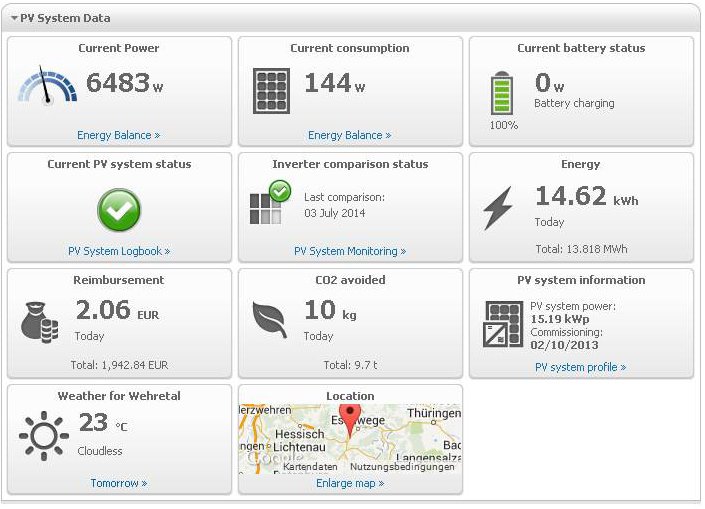
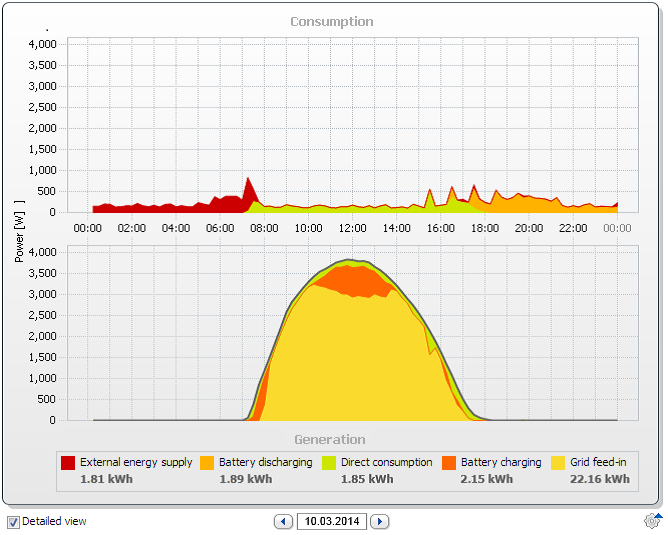
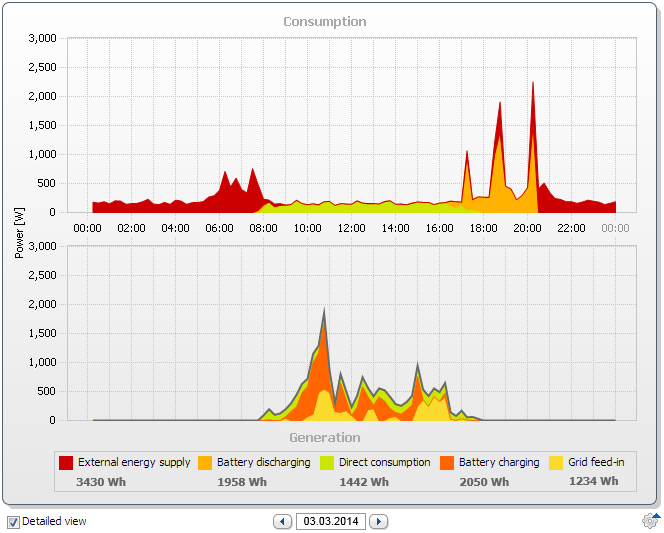
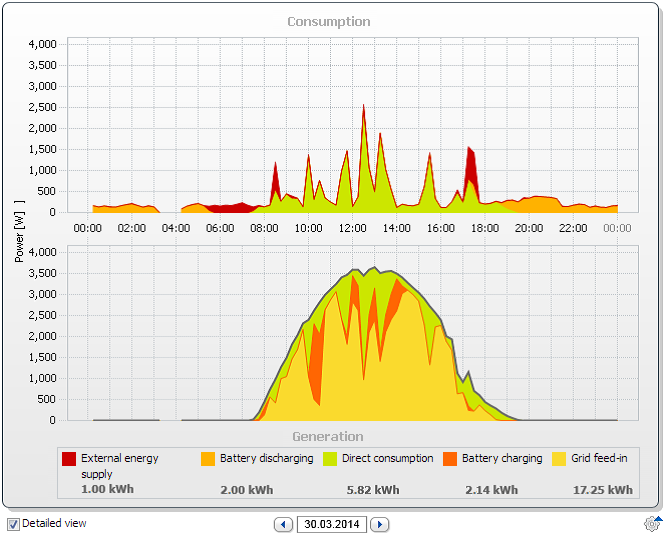

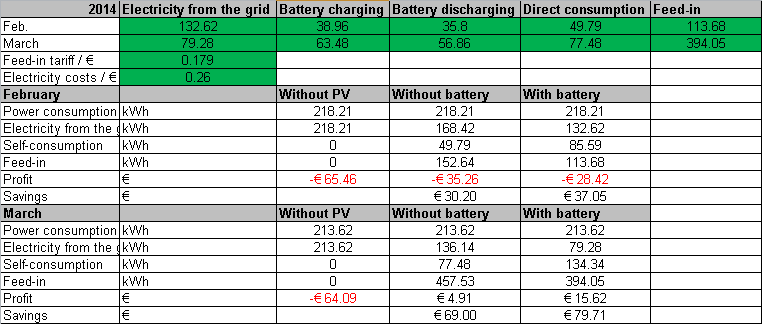


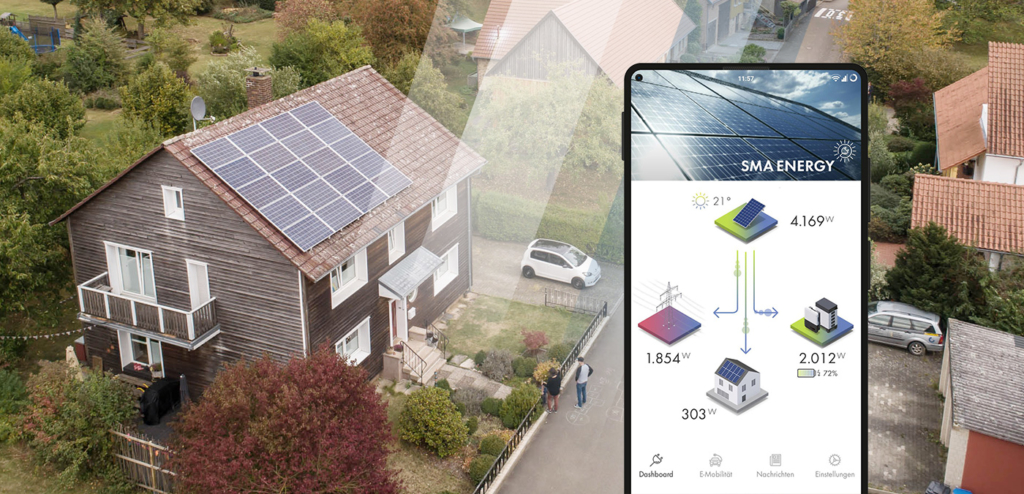
Hi,
With its battery pack, does sunny boy smart energy works as off-grid inverter ?
Hi Khamis,
no, the Sunny Boy Smart Energy works only on-grid connected.
Regards,
Annika
what if the PV power array IS BIG ENOUGH , THE SUN IS SHINING AND MY GRID IS GONE DOWN , WHAT IS THE POINT IF I HAVE ENOUGH ENERGY BUT I CAN’T USE IT BECAUSE THERE IS NO SIGNAL FROM THE GRID?!! WE FACE THIS PROBLEM FREQUENTLY IN IRAQ AND I HAVE NOTICE THAT THE SPS TECHNOLOGY IS NOT USED WITH 50HZ, 230V SYSTEMS AND NOW YOU SAID THAT THIS SYSTEM WILL NOT WORK WITHOUT GRID , HOW CAN WE SOLVE THIS PROBLEM ?
Hi Omer,
It is not easy to answer because more details are missing. Please ask better direct to serviceline-international@sma.de.
Many thanks in advance.
Kind regards, Annika
Hello
I have a photovoltaic system on grid.
Improving and expanding its wish.
Consumption is not constant and those are the moments in which excess energy produced is exported to the national grid but not paid feed in tariff.
The solution that we seek is filling system for accumulating and managing this accumulations (batteries)
Thus we found your products’ SUNNY BOY
3600/5000 ENERGY SMART ‘
Can you provide me more information?
How and where can I buy such a system?
Respectfully
N.CAZAN
Hey, Thanks for your request. Where are you from?
Best regards
Leonie
Hello
I’m from Iasi, Romania
Wonderful system indeed. But here in NL , we can deliver energie back to the grid. Until 2020 at least. So until then, we have this really BIG battery called the grid and it’s “free” (that’s why the government is going to change the rules because they miss out on taxes)
After that, your battery will become intereesting. But only for those who produce really a lot more than they use because the extra cost of your combined system compared to a solar-only inverter is way too high to justify such an investment.
So I’ll probably have to put a bunch of cheap lead battaries in my garden shed :-).
Hi if i dont have internet connection can sunny smart energy still working well and can i put a wind fan with solar panels when sun rise i get power from battery or directly from the sun and withe the wind fan still get power without using battery
Hi Ezzat,
To answer you we would need some more details: Where are you from? Is it an off-grid application or an on-grid?
Have you already bought some devices or are you still in the planning phase?
Regards
Leonie
Hi,
we have a Sunny Boy 3600 with a 2kW/h battery pack. Is it possible to exchange the battery pack or add another battery pack to this inverter system? I would like to increase our storage possibilities with a larger battery pack.
Thanks & BR
Kristina
Hi Kristina,
unfortunately it isn`t possible to exchange the battery pack because it is exactly maintained for the inverter.
Best regards,
Julia
Hi SMA
i would like to logon with the app too my sunny boy. but i need an account .
can you let me know what account i have to use or where exactly to create it .
thanks
Daniel
Hi Daniel,
In order to use the App, it’s necessary that you have an account in Sunny Portal. So, please register your devices in Sunny Portal. After that, you can see your data with the App.
Have a nice weekend.
Best regards,
Sarah
There is a mistake in profit calculation.
For example in Fabruary without battery he took the whole consumption 218,21*0,26 – 40,27= 16,47 Euro payment (-16,47). To be correct we have to take 168,42*0,26-40,27=3,52 Euro payment (-3,52). So we gonna pay 3,52 but not 16,47
I like the detailed description and comparison of the two typical days. Would be good to see how it works out with a load profile of a small family with people at home during the day.
I assume the system can go through multiple charge/discharge cycles during the day if you have a peaky load and the energy demand exceeds the solar panel output?
Hi Georg,
Thanks for your comment. For more exmaples please feel free to click through this pv plant: https://www.sunnyportal.com/FixedPages/HoManLive.aspx
Bests Leonie
Great article. I have a similar consumption as the article. 2600 Kw per year. I have looked into a Hybrid system with a larger battery system, but the cost is too high. I like the idea of this smaller system. The power company here have reduced the buy back rate to 7 cents a unit so it is time to look at storage rather than exporting most of my solar generation. What would be the cost of the system and when would it be available in New Zealand
Hey David,
Thanks for your comment. The system is available via SMA Australia. Please contact them for more information: http://www.sma-australia.com.au/contact/contact-form.html
Best regards
Leonie
Interesting article.
If you go to the financial analysis shown on the last table, your monthly bill in February and March is around 65 Euro without PV; you gain around 50 Euro as an average with PV and 58 Euro with PV and battery.
What is the payback time of your PV without battery and with battery if you consider the average of February and march as a tipical month? Or what is the price you payed in Germany for the PV system without and with the battery?
Thank you.
Hi,
Unfortunately Armin isn’t working for SMA anymore. That’s why he can’t answer your question in person.
As we don’t sell the inverters to end customers, please ask your installer or wholesale for prices in your region.
You can also check internetshops for a first appraisement.
Best regards
Leonie
Can sunny boy smart energy charge the battery from the grid supply?
Hi Seksak,
No, this isn`t possible. The Sunny Boy Smart Energy can`t load the battery from the AC side.
The battery is charged directly by the DC side of the inverter.
Best regards
Leonie
Will the Sunny boy Smart Energy still deliver power from pv array to household if the utility grid is off?
Hi Bertus,
In case of a blackout, the Sunny Boy will be cut off the grid, but the battery will be still loading.
Best regards
Leonie
can I consider that this inverter is on/off grid inverter ?
Hi Mohammed,
The Sunny Boy Smart Energy is only suitable as on-grid inverter.
Best regards
Leonie
Excellent! The best lithium battery for this application is Lithium Titanate Li4Ti5O12 (20,000 discharge cycles). For a six month solar year the battery would last 110 years? Too expensive of course so what type of battery chemistry did you end up using?
Given that sub stations are not going to be smart any time soon this product makes the home smart instead. The difficulty for sub stations with PV is that the voltage must fall between limits plus unbalanced PV across phases can overheat sub station transformers. It would be nice to see a power divert to battery then hot water and lastly grid to keep the pressure off grid distribution.
Why didn’t you add a hot water divert feature in these units?
Hi! This is a very interesting article. I am considering upgrading our inverter to one of these, but wonder if our smaller 1.7 kWp system means that it makes financial sense to do so. What sums do I need to do to find out?
Hello Toby,
many thanks – your request has been sent and will be processed as soon as possible by SMA UK.
Best regards
Horst
I need quotation for power inverter sunny tripower 10000TL and how many days to receive it in Kuwait . Thanks in advance
Hello Nahla,
our team will contact you via email and provide more details on this topic.
Enjoy the day and all the best,
Horst